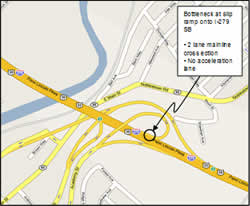FHWA Localized Bottleneck Reduction Program
Case Study
Printable Version [PDF 104KB]
You may need the Adobe® Reader® to view the PDF on this page.
 Study Area (map "for placement only")
Study Area (map "for placement only")
Location – Pittsburgh, Pennsylvania
I-279 at the Carnegie Interchange in Pittsburgh, Pennsylvania.
Problem – Inadequate acceleration lane
The existing slip on-ramp from Academy Street onto southbound I-279 has been a major traffic bottleneck and high accident location for many years. The on-ramp did not have an acceleration lane to allow for the smooth merging of traffic entering the freeway. Thus, vehicles often came to a complete stop to wait for an acceptable gap in traffic. With high Interstate traffic volumes and typically high travel speeds, the existing configuration created an unsafe and inefficient merge condition. Accident rates at this location were high and traffic queues would regularly back-up on the ramp. Mainline traffic would also be slowed by driver uncertainty and friction created by the interchange. To further compound the problem, the freeway has two lanes in the southbound direction at the ramp location but widens to three lanes further downstream, making the ramp location even more evident as a bottleneck.
Solution – Convert shoulder to full-use lane
Traditional improvements such as widening the freeway were infeasible economically because they would require widening the bridge piers for the overhead road. Therefore, PennDOT and FHWA devised a low-cost solution which involves converting the existing right shoulder into a third freeway lane and re-striping the existing ramp to allow oncoming traffic to continue onto the freeway without stopping. The added third lane will be extended to tie in with the existing third lane of mainline traffic 800 feet downstream. The work will entail milling and resurfacing the shoulder to accommodate traffic, re-striping the ramp and mainline, and making minor changes to the ramp taper, with an estimated cost of $250,000. The project will completely remove the merge condition and bottleneck at the freeway entrance and eliminate ramp and mainline queues. Although the conversion of the shoulder will result in no shoulder presence for the length of the new lane segment, it was determined that a design exception was appropriate given the significant operational and safety benefits to result from the change. The work was scheduled to be completed in October 2007.
Lesson Learned
This project demonstrates that low-cost, low-impact bottleneck improvements can make significant improvements in traffic flow.